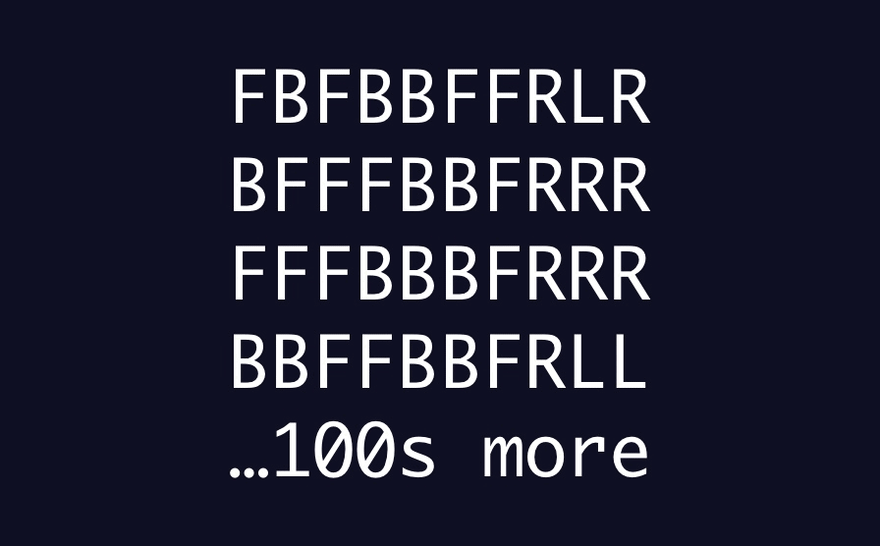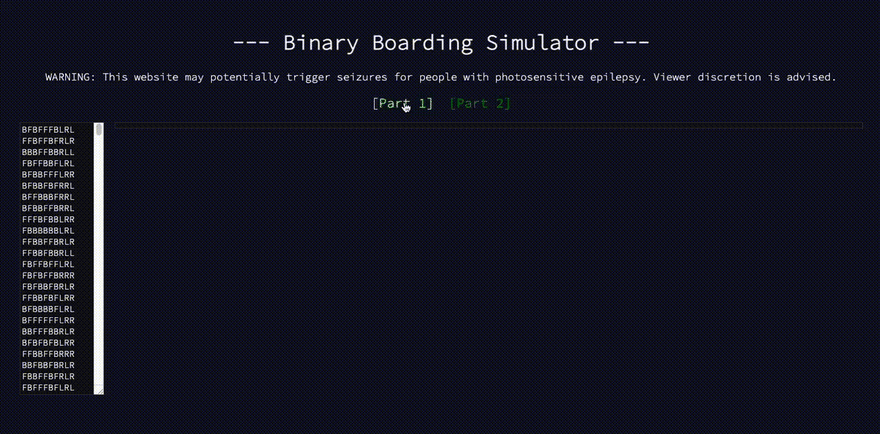Advent of Code 2020 Day 5
Try the simulator!
Task: Solve for X where...
Part 1:
X = the highest boarding pass ID
Part 2:
X = my boarding pass ID
Example input
FBFBBFFRLR
BFFFBBFRRR
FFFBBBFRRR
BBFFBBFRLL
It represents:
- A list of encrypted boarding pass IDs
Part 1
- Using the title as a hint
- Writing a working algorithm
- Building the simulator
Using the title as a hint
- The title is
BinaryBoarding - The instructions further suggest going one of two directions based on the character encountered
- The solution seems clear
Given this boarding pass
FBFBBFFRLR
Splitting FB from RL
FBFBBFF RLR
Replacing Fs and Rs with 1s, Bs and Ls with 0s
1010011 101
Parsing each one as a decimal
44 5
Generating the ID
44 * 8 + 5 = 357
Writing a working algorithm
Split the input at each new-line character into an array of strings
For each string
Change the string according to the following instructions:
Split the string into groups containing exclusively FBs and RLs
Replace FBs with 1 and RLs with 0
Parse the modified string as a decimal
Calculate the sum of:
The product of the first decimal and 8
And the second decimal
Return the sum
Return the highest number in the modified list of decimals
Here's a visualization of my algorithm for Part 1

Building the simulator
- Since these are boarding pass IDs, I wanted to simulate the population of a plane's seating chart
- By the end of running Part 1, there should be one seat left unfilled: that's my seat!
Part 2
- Writing a slightly modified, working algorithm
- Finishing the simulator
Writing a slightly modified, working algorithm
- I still need to generate the list of boarding pass IDs
- But now I need to sort them in ascending order
- And I need to find the only gap: where the number increments by 2 instead of 1
Split the input at each new-line character into an array of strings
For each string
Change the string according to the following instructions:
Split the string into groups containing exclusively FBs and RLs
Replace FBs with 1 and RLs with 0
Parse the modified string as a decimal
Calculate the sum of:
The product of the first decimal and 8
And the second decimal
Return the sum
Sort the list of decimals in ascending order
Filter the list to exclude all but one number:
Find the number where the number at the very next location is not equal to this number plus one
Since the number found is the seat next to mine
Return that number plus one
Here's a visualization of my algorithm for Part 2

Finishing the simulator
As foreshadowed above, I wanted Part 2 to reveal the seat that in Part 1 was the only gap
This puzzle felt easy.
That made me feel great about my progress.
Bring on the next one!




Top comments (0)